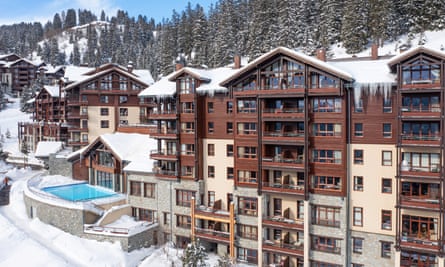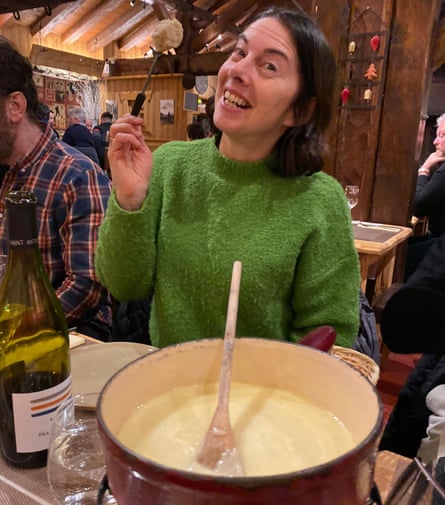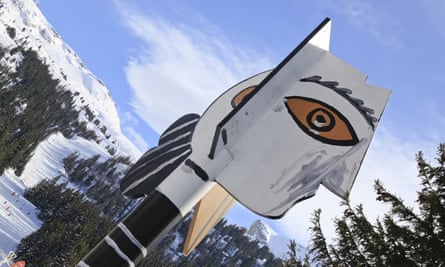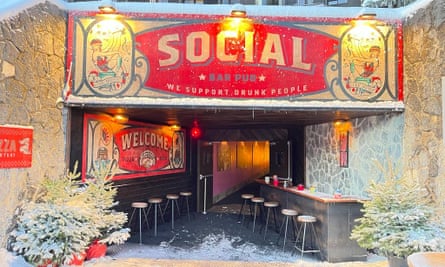When it comes to organising ski trips, finding the “happy intermediate” level can be tricky. Friends will say things like, “It’s fine, I’ll ski blues”, then lead you down a steep red, leaving you broken and weeping before elevenses.
I’ll sometimes push myself down tough slopes, but I’m just as happy cruising serpentine blues and greens while admiring the scenery, looking at birds and making the occasional snow angel.
The resort of Flaine, in France’s Haute-Savoie department, proved a good place to brush up on my technique last year. A relatively easy journey by train and bus, it has tougher slopes, but its 69 beginner and 49 intermediate runs suit lapsed or less confident skiers, too. I hadn’t skied for almost a decade and took two mornings’ instruction with the ski school ESF.
“Teresa: spring! Use your legs to spring! Up down, up down. Feel the rhythm. Skis closer together. Look downhill to the trees – not at your feet.” My instructor, Virgine, had a job on.
Besides its generous sprinkling of gentler runs, Flaine’s environment-aware credentials and architectural legacy also appealed to me. Not many ski resorts can boast an installation by Picasso, a sculpture by Belgium’s Pol Bury and design aspects that flirted with sustainability as far back as the 1960s.

Our group travelled from London by train to Cluses, via Paris, and then took the shuttle bus to our ski-in ski-out apartments at Les Terrasses d’Eos, on a slope above Flaine’s pedestrianised centre. Surrounded by spruce trees, the contemporary wood-and-stone apartments are Green Key-certified and ideal for skiers who like the freedom of self-catering but also enjoy the benefits of an on-site bar, restaurant and spa. The roomy apartments sleep from four (one bedroom) to 10 and have wood fittings, balconies, dining areas, fireplaces and well-equipped kitchenettes, while L’Eterlou restaurant serves fine Savoyard produce.
Our visit last winter was a trip of two halves. We arrived to find several lifts closed, and big bald patches where there should have been snow; we left four days later in a thigh-deep whiteout that left our transfer minibus in need of a tow from a passing taxi.
There has been good snowfall so far this season, though the reality is that ski seasons are becoming less predictable – something the wider Grand Massif ski region is trying to mitigate. Flaine itself is involved in reforestation and wetland-restoration projects, snow groomers have switched to HVO100 synthetic fuel and some lifts now run on it, too (though the use of biofuels is still controversial). Free digital piste maps have mostly replaced printed versions (the money from those still sold goes towards tree planting).

In 2007 Flaine was the first ski resort in Europe to begin surveying and monitoring surrounding landscape, geology, water sources, flora and fauna. The survey area now covers neighbouring villages and ski resorts of Les Carroz, Morillon, Samoëns and Sixt. These mountains are home to ibex, black grouse, chamois, bearded vultures and the endemic rock ptarmigan. Observations have led to the creation of winter migration reserves for black grouse and ptarmigan, “umbrella species” whose protection also helps preserve the habitats of other animals.
“Monitoring biodiversity helps us to preserve and restore sensitive areas,” said Malvina Sculo, Flaine’s sustainable development manager, over lunch at the slope-side restaurant La Joyeuse Flainoise. “Knowing where the sensitive places are means we can leave them to birds and other wildlife.” These areas are identified by bird flags, and signs on the red piste called Combe de Vernant, which runs into the Vernant Valley, as well as on the piste map. Visitors can join a guide for a free three-hour wildlife observation tour (Sundays, Mondays, Tuesdays and Fridays at 10.30am or 1pm from the Désert Blanc chairlift).
Away from the slopes, Flaine’s brutalist grey concrete architecture can be hard to love on a dull winter’s day, but in the 1960s it was part of a blueprint for a modern, functional resort, the vision of a wealthy geophysicist, Eric Boissonnas, and his, wife, Sylvie. Patrons of the arts and passionate skiers, the pair enlisted Marcel Breuer – the Bauhaus master from Pécs, Hungary, who had put his name to the Wassily chair and New York’s Whitney Museum of American Art – to create something fresh and modern. Breuer’s first thought on seeing the site from a helicopter was how to avoid spoiling it. He found his cue in Flaine’s grey-marled cliffs, which proved a perfect foil for his utilitarian build.
after newsletter promotion

The story is told at Flaine’s visitor centre and on a guided heritage tour (Tuesdays, 2pm, in front of the Arts Centre) that includes the 1973-built ecumenical chapel, complete with Marcel Breuer candle holders, and the Auditorium, home to a Pol Bury foundation. You can guide yourself around the striking art that brightens the pedestrianised centre, including sculptures by Vasarely and Dubuffet and a large version of Picasso’s Tete de Femme (Head of a Woman) and it’s worth visiting the 1968-built Hotel Le Flaine, where the lounge extends to a large “hanging” sun terrace, and the Totem hotel, to see a Breuer-designed concrete fireplace (there is another in the Loft suite) and an original Wassily chair.
After a day exploring town or out skiing, it was lovely to chill in the hammam and heated outdoor pool at Les Terrasses d’Eos. If we chose not to eat in, a free shuttle took us back into town for calorific fondue and hot-stone veggies and meats at Le Michet, or tartiflette served bubbling in the pan at the informal and relaxed Sabaudia. Flaine isn’t known for its wild apres-ski, but bar Le Social was lively (if it’s not happening here – tequila shots, whisky chasers, 80s metal, 70s disco and the occasional stripped-to-the-waist Brit dancing on the bar – it’s probably not happening elsewhere).

While the weather limited my time on the slopes, it was enough to refresh muscle memory. Thanks to Virginie and Raphael, who ironed out creases in my technique, I had progressed to a pole-planting and mostly parallel skier, in just two days. My co-skiers enjoyed black runs, but I soon felt confident enough to ski alone on forest trails, eyes peeled for marmots, grouse and golden eagles.
Had I been there longer, I would have taken a guided snowshoeing hike or joined a tasting at the top of the Grands Vans chairlift. The quality and origin label, Origine Grand Massif (Made in Grand Massif), champions local producers, creatives and artisans and weekly tastings are a great way to try local honey, cheeses, chocolates and pates – and a perfect reward for all the (literal) legwork I’d done on this trip.
The trip was provided by Pierre & Vacances. A seven-night stay at Les Terrasses d’Eos costs from £265pp based on four sharing a one-bedroom apartment with Pierre & Vacances. Return train tickets from London St Pancras to Cluses, including Eurostar, cost from £207pp, with two changes. The one-hour shuttle bus from Cluses to Flaine costs €19 return. A one-day ski Flaine area ski pass costs €53 (child €42.40). A six-day pass for the Grand Massif ski area costs €345 (child €276). Pierre & Vacances offers a 15% discount when booked with accommodation. Under-eights and over-75s ski free










